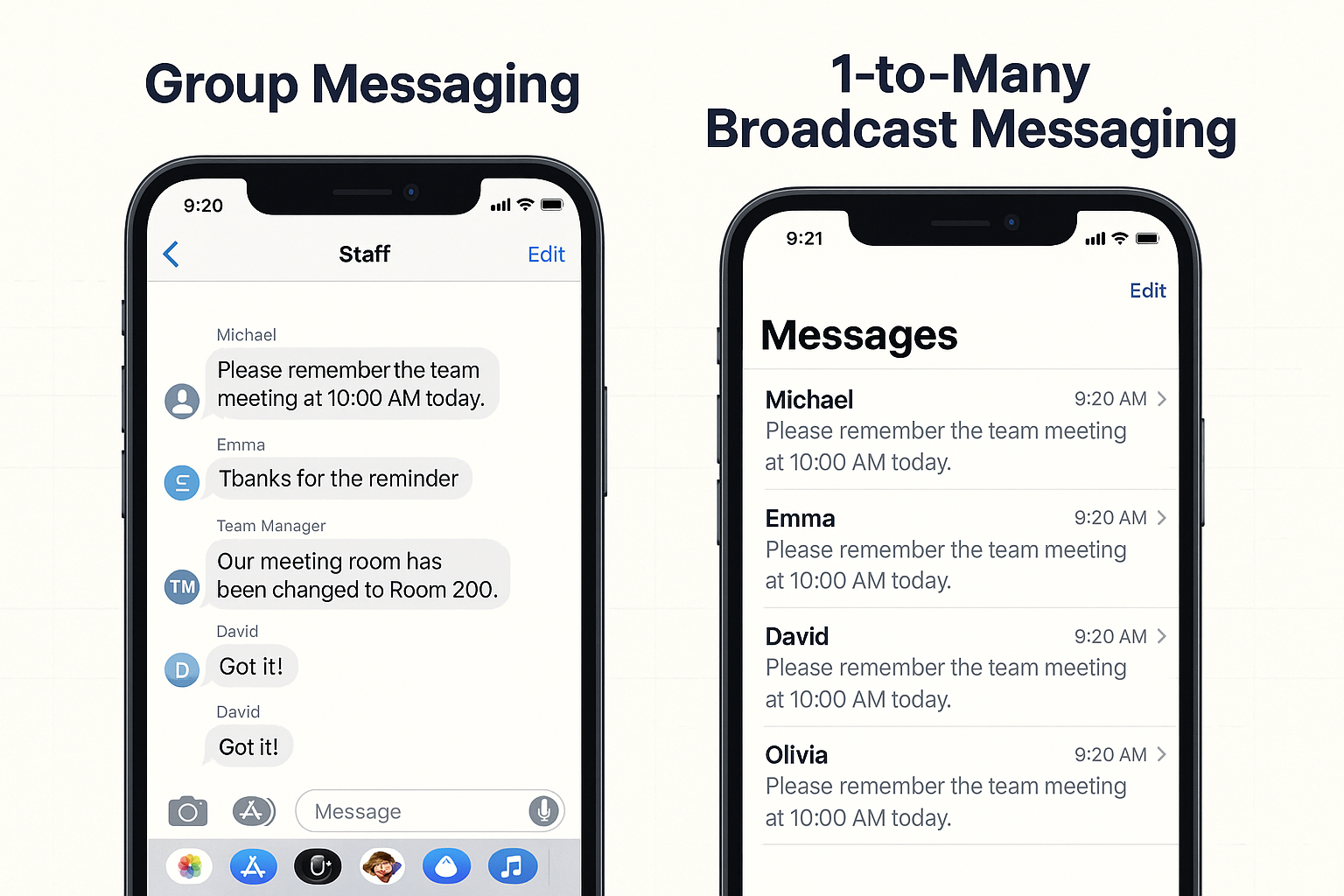Messaging with MessageDesk
MessageDesk supports the following types of messages:- 1-on-1 individual SMS/MMS
- 1-to-many text message broadcasts
- Group SMS
- Multimedia messages (MMS) in any thread
- 2FA (two-factor) (receive-only)
- Internal comments (private, team-only)
- RCS (coming soon)
- WhatsApp (coming soon)
- Email (coming soon)
Import historical messages: You can import past messages into MessageDesk to maintain conversation continuity. Learn more in the Data Center documentation.
1-on-1 individual text messages
Private, one-to-one messages with a single contact. Each conversation is its own thread in your shared inbox, so your team has full context and can assign, filter, and follow up without stepping on each other. Best for: Conversational, back-and-forth service and support. How 1-on-1 individual messages work: You text one person. Their replies stay in the same private thread. Advantages:- Keep conversations private and easy to follow.
- Route and assign to the right teammate from the shared inbox.
- Great for personalized, contextual help.
- One conversation at a time.
- Not efficient for announcements to many people.
1-to-many text message broadcasts
Your megaphone—send one message to many contacts at once. Replies come back as private 1-on-1 threads so you can triage and follow up quickly. (This is why broadcasts scale and stay personal.) Best for: Announcements, reminders, alerts, promotions. How broadcasts work: Create a group/list and send. Every reply opens a private thread for you. Advantages:- Reach many people with one send.
- Every reply is private—no “reply all” disasters.
- Combine with templates and scheduling for speed.
- Currently limited to 100 contacts per send.
- Best for one-way notices; not for group collaboration.
- Be mindful of consent and opt-out language for non-conversational texts.
Pro tip: Segment first. Targeted broadcasts get better engagement and fewer opt-outs.

Group SMS
Group SMS messages create a text thread where all message recipients can see and respond to all messages within the text thread.
- Creates a shared conversation where everyone can see, respond, and participate.
- Works well for small, collaborative discussions.
- Every reply alerts all recipients (which can quickly become noisy).
- Limited to 7 total participants - not including the sender.
- Difficult to add or remove participants after the group is created.

Multimedia text messages (MMS)
Multimedia text messages, or MMS for short, are available for all messaging types. You can attach media to individual, broadcast, and group text message conversations. Best for: Visual messages like How multimedia text messaging works: Attach your media to any text message and send. Advantages:- Faster than email for “show me” moments.
- Reduces back-and-forth and shortens resolution time.
- Carrier media file size limits apply.
Sharing media files with MessageDesk
Learn more about sending and receiving media files, including file size restrictions.
2FA (two-factor) authentication text messages
These are transactional codes typically sent from a 5- or 6-digit short code. MessageDesk connected numbers can only receive 2FA codes from shortcode phone numbers. Best for: Receiving account-security codes on a shared team number. **How 2FA messaging works: **Your connected number receives 2FA messages like any other text. Advantages:- Keep security-related messages in the same customer thread.
- Maintain a record alongside other messages in your shared inbox.
- MessageDesk connected phone numbers are only capable of receiving these types of text messages, not generating them or sending from a shortcode phone number.
Internal comments
Leave private notes right inside a text message conversation. Contacts never see these; they’re team-only for handoffs and internal support. Best for: Handoffs, support, approvals—anything your contact shouldn’t see. How internal comments work: Add a comment to the thread; assign/mention teammates. Advantages:- Keep the context within the conversation.
- Reduce “who said what” confusion across shifts.
- Only visible to MessageDesk users within your MessageDesk workspace.
Learn more about comments and mentions
Check out how to use comments and mentions for team collaboration.

